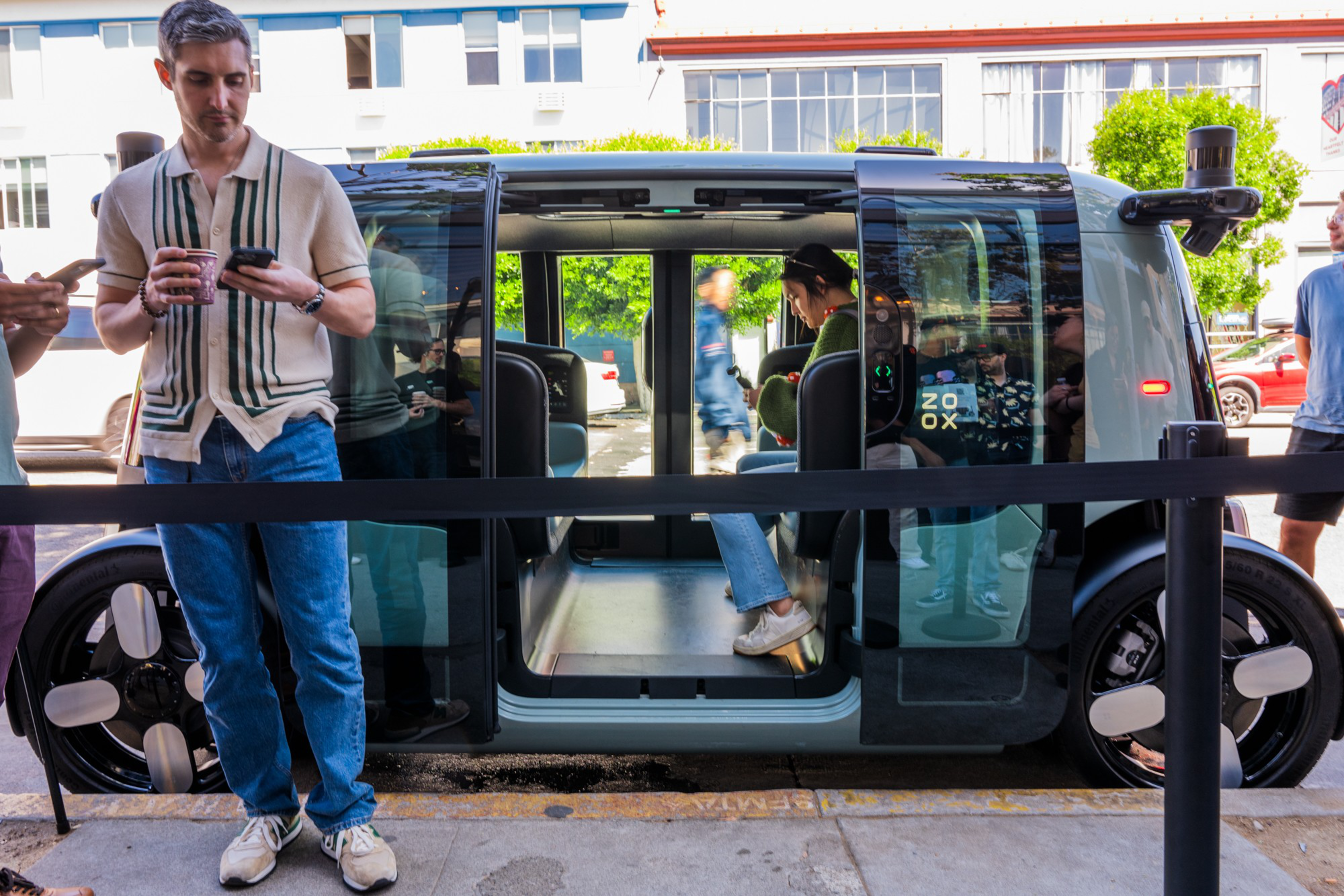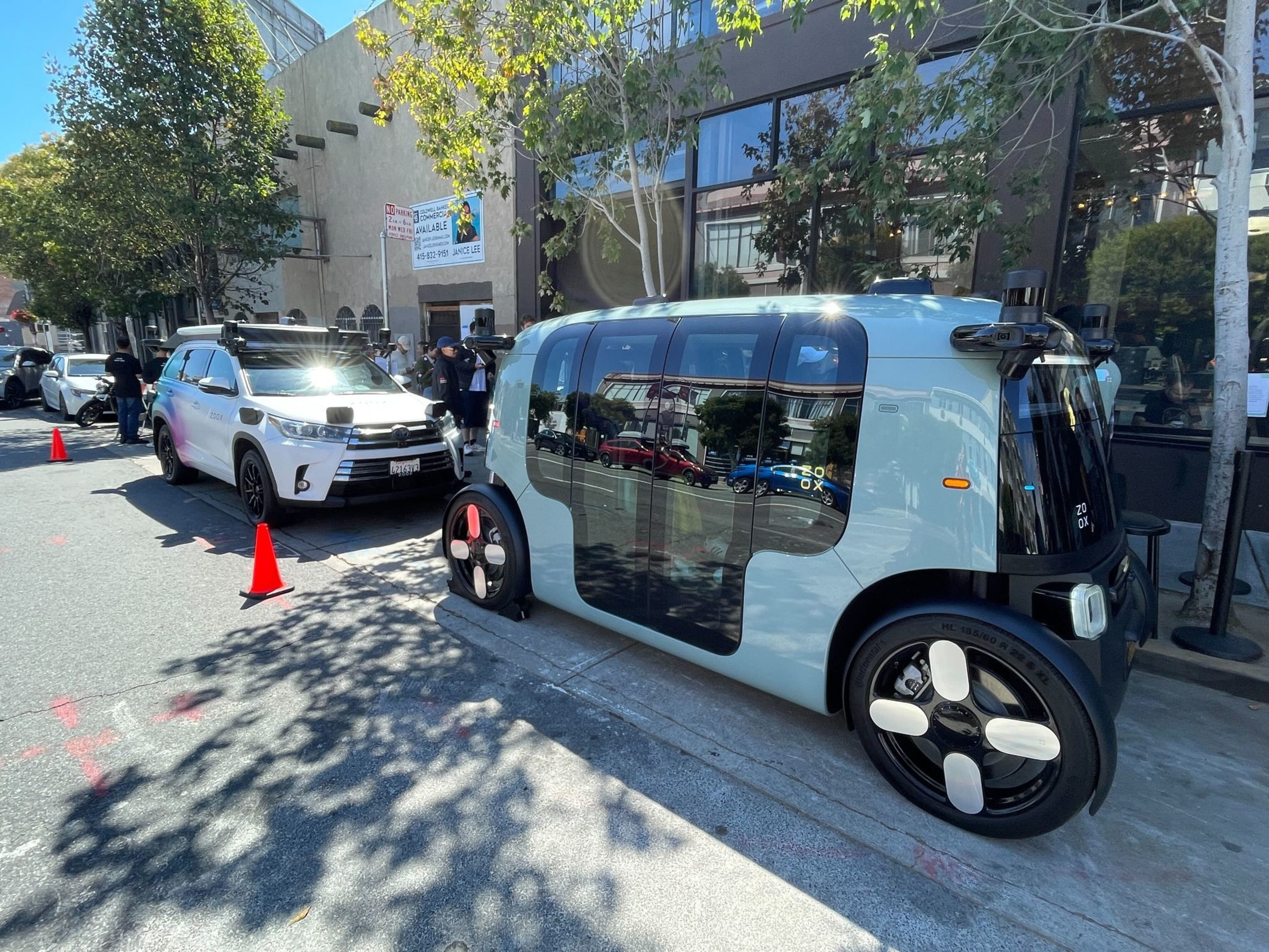Sightglass Coffee, a hip small-batch café in SoMa, had a line snaking outside on Saturday, but it was self-driving car curiosity instead of caffeine drawing the crowd.
Zoox, the Amazon-owned robotaxi company, was holding the first in a series of “open houses (opens in new tab)” around San Francisco to show off its vehicle before launching on city streets. The company currently has permission (opens in new tab) to ferry employees on public roads around its Foster City HQ and a set route in Las Vegas with a 45-mph speed limit.
Amid Waymo’s steady drive to dominate San Francisco, Zoox representatives declined to offer any update on when its service would launch in SF, other than the incredibly nebulous “soon.” Workers did not answer any specific questions about service hours or areas.
Still, the company sees these open houses as a way to introduce itself to the public and address apprehension and excitement around its design, a spokesperson said. At the event, Zoox treated people to free coffee and the chance to sit inside the vehicle. To the disappointment (opens in new tab) of several attendees, however, the robotaxi remained stationary throughout the event.
“I love the industrial design of it,” said Sean Carter, who decided to stop by after seeing an advertisement for the event on social media.

Using the term “car” might not be the most apt description. Unlike current robotaxis on the road, the Zoox vehicle has no steering wheel — or any “driver’s seat” at all. With its four-wheel steering, the boxy little shuttle technically has no back or front and can drive in either direction.
The four seats in the interior face inward like a carriage, and each one has its own temperature settings and phone charger. On the ceiling are tiny star-like lights, as well as a camera and speaker system that lets workers view and talk to riders during their journey. (A spokesperson was quick to add that technicians will check in through the cameras at the beginning and end of a ride, but won’t watch riders during their actual trips).
Those behind-the-scenes humans can also direct the cars (opens in new tab) if they face unexpected obstacles, like construction or an accident.
“The bidirectional design is fascinating,” Carter said, describing the car’s aesthetic as a futuristic version of a retro hot dog toaster (opens in new tab) (“down to the seafoam green”).

Friends Aditya Kallepalli and Neil Chiruvella, who popped into the event after noticing the commotion while driving by, also praised the car’s design.
“I like how Zoox is trying to move away from the standard car model,” Chiruvella said. “People need to stop thinking of them as cars, necessarily, and more like infrastructure.”
The duo are regular Waymo riders, which they prefer over normal ride-hailing services. “It doesn’t feel like you’re a guest in a Waymo,” Chiruvella said. “In an Uber, you’re a guest of the driver.”
Alphabet-owned Waymo has a big head start: It’s been offering paid rides to anyone in San Francisco since June, and has made more than 2 million trips (opens in new tab).
While Kallepalli said he would select the cheapest option once the Bay Area has more robotaxis on the road, Chiruvella had a more pointed take. “I would choose based on who I thought had the best technology and the best plan for how to create a usable system in the city, versus just chasing profits,” he said.
Jefferson Ly and Reece Labson, who use Waymo frequently and previously served as beta testers for Cruise, said they hope that when Zoox launches it will be better than Waymo at nailing pickup and drop-off locations.
The duo was waiting for a Waymo car and gestured to the app with exasperation as the robotaxi had to go around the block to find a spot to pull over.
Philipp Alvares (opens in new tab), a reporter for German publication Handelsblatt, stopped by the Zoox event with his 4-year-old daughter, who had just taken her first-ever Waymo ride to get there.
“For children, it’s like magic,” he said. He and his wife have already imagined a future for their child where robotaxis or personally owned self-driving cars become the norm: “Maybe she won’t even need a driver’s license anymore. Because why bother?”
